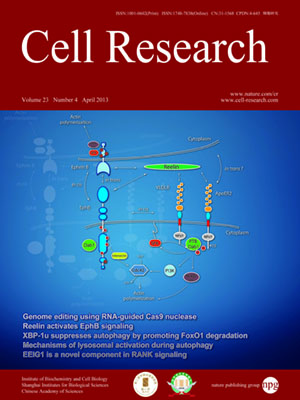
Volume 23, No 4, Apr 2013
ISSN: 1001-0602
EISSN: 1748-7838 2018
impact factor 17.848*
(Clarivate Analytics, 2019)
Volume 23 Issue 4, April 2013: 552-564
ORIGINAL ARTICLES
RFP-mediated ubiquitination of PTEN modulates its effect on AKT activation
James T Lee1, Jing Shan1, Jiayun Zhong1, Muyang Li1, Brenda Zhou1, Amanda Zhou1, Ramon Parsons1 and Wei Gu1
1Institute for Cancer Genetics, and Department of Pathology and Cell Biology, College of Physicians and Surgeons, Columbia University, 1130 St Nicholas Avenue, New York, NY 10032, USA
Correspondence: Wei Gu(wg8@columbia.edu)
The PTEN tumor suppressor is a lipid phosphatase that has a central role in regulating the phosphatidylinositol-3-kinase (PI3K) signal transduction cascade. Nevertheless, the mechanism by which the PTEN activity is regulated in cells needs further elucidation. Although previous studies have shown that ubiquitination of PTEN can modulate its stability and subcellular localization, the role of ubiquitination in the most critical aspect of PTEN function, its phosphatase activity, has not been fully addressed. Here, we identify a novel E3 ubiquitin ligase of PTEN, Ret finger protein (RFP), that is able to promote atypical polyubiquitinations of PTEN. These ubiquitinations do not lead to PTEN instability or relocalization, but rather significantly inhibit PTEN phosphatase activity and therefore modulate its ability to regulate the PI3K signal transduction cascade. Indeed, RFP overexpression relieves PTEN-mediated inhibitory effects on AKT activation; in contrast, RNAi-mediated knockdown of endogenous RFP enhances the ability of PTEN to suppress AKT activation. Moreover, RFP-mediated ubiquitination of PTEN inhibits PTEN-dependent activation of TRAIL expression and also suppresses its ability to induce apoptosis. Our findings demonstrate a crucial role of RFP-mediated ubiquitination in controlling PTEN activity.
Cell Research (2013) 23:552–564. doi:10.1038/cr.2013.27; published online 19 February 2013
FULL TEXT | PDF
Browse 2428


